Dalam bahasa Inggris, pasta adalah sebutan untuk berbagai jenis masakan dengan bahan utama salah satu jenis pasta yang diberi bumbu dan saus. Pasta berasal dari bahasa Italia "pasta alimentare" yang berarti adonan bahan makanan. Dalam arti luas, "pasta" bisa berarti semua adonan seperti adonan roti, pastry, atau cake. Dalam bahasa Italia, pasta yang berarti bahan makanan seperti mi disebut pastasciutta.
Pasta dibuat dari tepung terigu semolina yang merupakan hasil gilingan biji gandum durum dicampur telur sehingga sedikit berwarna kuning cerah, dan bila dimasak dengan benar akan menghasilkan tekstur sedikit kenyal. Pasta buatan Amerika sering dibuat dari campuran tepung terigu Farina dan Semolina, sehingga mempunyai tekstur yang lebih lembut untuk dijadikan hidangan seperti kaserol.
Di luar negara asalnya di Italia, pasta biasanya dijual di dalam kemasan dalam bentuk kering. Pasta kering dibuat di pabrik dengan menggunakan mesin ekstrusi yang mendorong keluar adonan pasta melalui lubang-lubang saringan. Bentuk-bentuk pasta yang lain diperoleh dengan menggiling adonan pasta menjadi lembaran yang kemudian dipotong-potong atau dicetak.
Pasta segar buatan rumah tangga dan restoran dibentuk dengan tangan beberapa saat sebelum pasta direbus. Pasta segar memerlukan waktu masak yang singkat, namun pasta segar tidak tahan lama disimpan karena memiliki kadar air yang tinggi. Pasta kering bisa tahan lama disimpan hingga 3 tahun atau lebih karena hanya memiliki kandungan air sebanyak 10%. Pasta yang sudah dimasak dan tinggal dipanaskan dengan oven microwave juga sering dijumpai di bagian makanan beku pasar swalayan.
Sejarah
Makanan mirip pasta banyak dijumpai di berbagai tempat di dunia sejak zaman dulu, terutama di wilayah dengan penduduk yang menjadikan gandum dan serealia sebagai makanan utama. Gandum yang sudah digiling sering dimasak sebagai bubur atau dihaluskan menjadi tepung dan dibuat roti. Pasta kemungkinan besar merupakan alternatif dari bubur atau roti, karena pasta merupakan makanan awetan yang dibuat tanpa perlu dimasak.Di Eropa, catatan tertulis paling tua tentang makanan serupa mi ditemukan pada hiasan makam orang Etruscan di Italia Tengah yang berasal dari tahun 400 SM. Di Tiongkok, mi sudah dikenal sejak tahun 2000 SM berdasarkan hasil penggalian di situs Lajia (Tiongkok barat) yang terletak di tepi Sungai Kuning. Di bawah lapisan tanah jenis tanah loess yang tebal di situs penggalian yang sudah rusak akibat gempa bumi dan banjir ditermukan mi berwarna kuning di dalam panci tanah liat yang terbalik. Panjang mi sekitar setengah meter dengan diameter 3 milimeter. Hasil analisis menunjukkan mi dibuat dari tepung biji milet.
Italian Pasta Through the Ages
Many schoolchildren were taught that the Venetian merchant Marco Polo brought back pasta from his journeys in China. Another version states that Polo discovery was actually a rediscovery of a foodstuff that was once popular in Italy in Etruscan and Roman times. Well Marco Polo might have done amazing things on his journey but bringing pasta to Italy was not one of them, it was already there in Polo's time. There is some evidence of an Etrusco-Roman noodle made from the same durum wheat as modern pasta called "lagane" (origin of the modern word for lasagna). However this food, first mentioned in the 1st century AD was not boiled like pasta, it was cooked in an oven. Therefore ancient lagane had some similarities, but cannot be considered pasta. The next culinary leap in the history of pasta would take place a few centuries later.

Spaghetti (at the time called macaroni) drying in streets of Naples circa 1895
By the 1300's dried pasta was very popular for its nutrition and long shelf life, making it ideal for long ship voyages. Pasta made it around the globe during the voyages of discovery a century later. By that time different shapes of pasta have appeared and new technology made pasta easier to make. With these innovations pasta truly became a part of Italian life. However the next big advancement in the history of pasta would not come until the 19th century when pasta met tomatoes.

Pasta Drying: Copyright Life In Italy
Pasta Today
It is estimated that Italians eat over sixty pounds of pasta per person, per year easily beating Americans, who eat about twenty pounds per person. This love of pasta in Italy far outstrips the large durum wheat production of the country; therefore Italy must import most of the wheat it uses for pasta. Today pasta is everywhere and can be found in dried (pasta secca) and fresh (pasta fresca) varieties depending on what the recipes call for. The main problem with pasta today is the use of mass production to fill a huge worldwide demand. And while pasta is made everywhere the product from Italy keeps to time-tested production methods that create a superior pasta.
Pasta History
Dried Pasta
There are roughly 350 different shapes and varieties of dried pasta in Italy, even more counting regional differences. Shapes range from simple tubes to bow ties (farfalle, which actually means "butterfly"), to unique shapes like tennis rackets (racchette). Many, but not all of these types are usually available wherever pasta is made. By Italian law dried pasta must be made with 100% durum semolina flour and water, a practice that all but the worst quality pasta makers worldwide have since adhered to. However there are two factors in dried pasta from Italy that make it typically better than most other products: extrusion and drying methods.Dried pasta, especially the more complex shapes (such as radiatore) are designed for grabbing and holding onto sauces. Dried tube pasta (ziti or penne) often has ridges or slight abrasions on the surface to hold onto the pasta sauce as well. These ridges and bumps are created during the extrusion process, when the pasta is forced from a copper mold and cut to desired length before drying. These molds, while expensive and prone to wear are favored for making the best dried pasta. However most producers worldwide use steel molds that produce pasta that is too smooth to hold onto sauce. Fortunately more pasta makers outside of Italy are starting to use the older style copper molds.
After the pasta is cut it must be dried using a process of specific temperature and time. This is another area where mass produced pasta falls short of good Italian pasta made the correct way. The mass produced pastas are dried at very high temperatures for a shorter time than quality pasta. Traditional pasta is allowed to dry slower, up to 50 hours at a much lower temperature. It is after the pasta is fully dried that it is packaged. The result is a product with a much better mouth-feel, quicker cooking time, and superior sauce holding noodles.

Fresh Pasta
Fresh Pasta
Essentially all pasta starts out as fresh pasta but some is made to be eaten "soft". Fresh pasta can be made with slightly different ingredients than the dried variety. Many northern regions of Italy use all-purpose flour and eggs while southern Italy usually makes theirs from semolina and water but it depends upon the recipe. Serving pasta that is made fresh that day shows a great deal of care in preparation and a high level of pride in the household's culinary skills. However fresh pasta is not inherently better than dried pasta, it is just different and is used in different situations. Some types of pasta are served only fresh, others only dried and some others can have fresh and dried versions. It is in this case that it can be argued that fresh is better than dried pasta. Fresh pasta has been made in households throughout Italy for generations but the region of Emilia-Romagna has the reputation of making the best. Here fresh pasta is often served with cream sauces or a simple sauce of butter and sage while light tomato sauces are reserved for the summer months. Following the simple but important rule of using fresh local ingredients, the Piedmontese serve their fresh pasta with a butter sauce covered with slices of decadent local black truffles. Wherever you are in Italy, being served fresh homemade pasta is a real treat as you can be assured that the pasta was made that day and will have a taste that will make you rethink notions of what good pasta is.Buying and Cooking Pasta
When buying either fresh or dried pasta, look for a well made brand that uses the best ingredients such as only semolina flour for dried pasta. The pasta should have a rough surface and not too smooth, as smooth pasta will not hold onto sauce. The noodles should be compact and heavy for their size in order to stay together when cooking. Remember to stay away from mass-produced cheap pasta, you will just be disappointed come dinnertime. For fresh pasta look for the expiration date on the package and take a good look at the pasta. If it looks cheap then it probably is, if the pasta feels heavy in the package and has a nice color and texture it is worth buying. Many Italian bakeries and grocerias also make fresh pasta that will be better than anything you could find at a supermarket and you may even get a family sauce recipe as well. However remember not to overcook your pasta, the worlds greatest sauce cannot save mushy pasta.When it comes to sauce it is really up to personal preference unless you are trying to follow a traditional recipe. A good rule is to remember simple pasta works best with simple sauces while complex shaped pastas are ideal for thicker sauces. There is no shortage of great pasta and sauce combinations and each is worth trying. However it is important that you use high quality pasta cooked properly to ensure authentic flavor.
Jenis pasta
Pasta terdiri dari berbagai bentuk dan ukuran. Di Italia terdapat lebih dari 650 jenis pasta dan hampir setiap tahun tercipta bentuk yang baru. Pasta yang berbentuk seperti panjang-panjang seperti mi disebut spageti, variasi yang lebih kurus disebut vermicelli, variasi yang panjang dan pipih seperti kwetiau disebut linguine, sedangkan versi yang agak tebal disebut fettucine.Nama jenis pasta biasanya diambil berdasarkan nama-nama bentuk pasta dalam bahasa Italia. Pasta berbentuk pendek-pendek seperti pena disebut penne, sedangkan pasta berbentuk kupu-kupu disebut farfalle. Jenis-jenis pasta selengkapnya bisa dilihat pada daftar nama pasta
Pappardelle adalah pasta yang secara fisik mirip banget dengan fettuccine, namun, ukurannya cenderung lebih pendek.. Pappardelle secara umum memiliki lebar sekitar 2 hingga 3 centimeter..
Pappardelle di italia sering disajikan dengan saus (maaf) babi ataupun saus kelinci..
Di italia sendiri ada festival pappardelle al cinghiale (pappardelle with wild boar festival) di kota gemmano pada emilia-romagna region, italia yang diadakan setiap bulan agustus..
Spoiler for gambar pappardelle:

Spoiler for gambar hasil olahan pappardelle:
 maaf gan sekedar mo nambahin, 1 jenis lagi yang modelnya mirip mie udon
(mie khas jepang), bundar, panjang, besar-besar, dan ditengahnya
biasanya berlubang (kadang nggak ada) namanya 'bucatini', modelnya macam
pic dibawah ini gan:
maaf gan sekedar mo nambahin, 1 jenis lagi yang modelnya mirip mie udon
(mie khas jepang), bundar, panjang, besar-besar, dan ditengahnya
biasanya berlubang (kadang nggak ada) namanya 'bucatini', modelnya macam
pic dibawah ini gan:
Spoiler for Gambar Bucatini:

Spoiler for Gambar Hasil Olahan Bucatini:
 Pasta ini merupakan pasta yang pipih mirip pelangi dan berwarna hijau karena terbuat dari campuran bayam dan telur..
Pasta ini merupakan pasta yang pipih mirip pelangi dan berwarna hijau karena terbuat dari campuran bayam dan telur..
Spoiler for Gambar Spinach Tagliatelle:

Spoiler for Gambar Hasil Olahan Spinach Tagliatelle:
 Gnocchi merupakan jenis pasta dari kentang yang rasanya kenyal gurih.
Saus keju gorgonzola dan krim yang gurih enak membuat pasta ini jadi
makin spesial rasanya. Bentuk Gnocchi cukup unik.. mirip seperti
bantalan kecil dengan beberapa ruas-ruas diatasnya..
Gnocchi merupakan jenis pasta dari kentang yang rasanya kenyal gurih.
Saus keju gorgonzola dan krim yang gurih enak membuat pasta ini jadi
makin spesial rasanya. Bentuk Gnocchi cukup unik.. mirip seperti
bantalan kecil dengan beberapa ruas-ruas diatasnya..
Spoiler for Gambar Gnocchi:

Spoiler for Gambar Hasil Olahan Gnocchi:

ada yg kurang gan cekidot
orzo pasta

merupakan pasta terkecil , menyerupai nasi
Spoiler for 0:

Spoiler for 0:

udha masuk pizza hut indonesia loh gan

Spageti
adalah pasta berbentuk seperti lidi panjang tanpa lubang. Biasanya
Spageti disajikan dengan saus tomat dan daging cincang.




Nilai gizi dalam pasta membuatnya menjadi primo piatto atau hidangan utama dalam kuliner Italia. Pada pasta yang terbuat dari tepung semolina, seperti makaroni, kandungan proteinnya sangat tinggi. Kandungan protein ini sekitar 12—14% sebelum dimasak dan menjadi 2—8% setelah dimasak.
Tak usah khawatir, pasta juga mengandung serat, yaitu sekitar 2—2,5 gram dalam tiap 100 gram. Serat baik untuk pencernaan kita. Bahkan, ada adonan pasta yang dicampur dengan sayuran seperti bayam.
Rendah Lemak dan Sodium
Kandungan lemak jenuh dalam pasta sedikit sekali dan hampir tidak mengandung kolesterol. Pasta juga rendah dalam kandungan sodium. Pasta tanpa telur memiliki kandungan sodium jauh lebih tinggi (150 miligram) dibanding pasta yang adonannya memakai telur (6,8 miligram). Kelebihan kolesterol atau sodium akan membuat peredaran darah kita tidak lancar.
Para Pendamping Pasta
Di Italia, hidangan pasta tidaklah lengkap tanpa para pendampingnya. Pendamping inilah yang membuat cita rasa pasta semakin kaya dan membuat kandungan gizinya semakin tinggi.
Tomat Tomat adalah primadona dalam kuliner Italia. Makanan khas seperti piza biasanya diolesi dengan saus tomat sebelum diberi bahan lainnya. Di Italia, tomat jenis san marzano dan pachino adalah yang paling baik untuk menjadi pendamping pasta.
Keju Kita tahu bahwa keju kaya akan kalsium dan rasanya enak. Karena itu, wajar jika keju disebut sebagai penyempurna hidangan pasta. Hampir semua jenis keju, yang keras seperti pecorino hingga mozzarella yang lembut, akan terasa pas untuk pasta.
Minyak Zaitun Minyak ini disebut “cairan emas” karena popularitasnya di Italia. Minyak zaitun adalah pengganti yang jauh lebih sehat bagi butter atau margarin. Dalam pasta, minyak zaitun dapat dipakai untuk menumis saus atau dilumuri langsung ke pasta yang sudah matang.
Basil dan Oregano Dua nama daun ini mungkin asing di telinga kita. Keduanya memiliki rasa yang tajam, pedas, dan sedikit pahit. Di Indonesia, rasanya agak mirip dengan daun kemangi. Kedua rempah-rempah ini membuat hidangan pasta menjadi segar.
Farfalle: Pasta bentuk dasi kupu-kupu dengan tepi bergerigi. Cocok untuk hidangan salad atau sajian utama dengan saus yang creamy, seperti Mornay Sauce.
Conchiglioni: Menyerupai kulit kerang. Lebih pas untuk isi sup, salad, dan sajian utama.
Cannelloni: Bentuknya seperti pipa berlubang dengan diameter 3cm, panjang + 5cm. Jenis lain cannellonidengan bentuk lebih pendek dikenal dengan nama rigatoni, sedangkan yang berujung serong disebut penne. Cocok dimasak dengan daging dan keju pada hidangan panggang maupun rebus.
Lasagna: Berbentuk lembaran tipis dengan panjang + 27 cm, lebar 5 cm. Dapat dijumpai dalam tiga warna, kuning untuk hidangan panggang, merah biasanya diolah dengan saus tomat, dan hijau cocok dipadu dengan bayam atau aneka sayuran.
Spaghetti: Bentuknya seperti lidi panjang tanpa lubang. Sangat cocok disajikan dengan saus bolognaise (saus tomat dengan daging cincang). Serupa dengan spaghetti tapi ukuran lebih kecil dan pendek dikenal dengan sebutan vermicelli. Pas diolah bersama hidangan laut., daging, maupun isi sup.
Fusilli: Bentuknya mirip spiral. Biasanya diolah dengan saus krim dengan tomat dan kacang polong.
Macaroni: Pasta bentuk pipa melengkung dengan lubang di tengahnya. Pas untuk hidangan panggang seperti macaroni schotel dan isi aneka sup.
Fettuccini: Bentuknya seperti kwetiau, pipih dan lebar. Dapat dijumpai dalam tiga warna, hijau dari sari bayam, hitam dari tinta cumi-cumi, dan kuning dari telur. Cocok dijadikan sajian utama dengan daging, keju, sayuran, atau seafood.
Pasta normally is white-yellow, but other colours exist. See here for the other pasta colours.
Below an overview of the most common pasta types and their synonyms.
Synonyms :
Sumber :
http://www.berani.co.id/Artikel_Detail.aspx?ID=5172
Spoiler for Gambar Spageti:

Spoiler for Gambar Hasil Olahan Spageti:

Spoiler for Jenis-jenis Pasta - Spaghettini:
Quote:
| Sama seperti Spageti, tapi Spaghettini berukuran lebih tipis dibandingkan Spageti bisasa
Spoiler for Gambar Spaghettini:

Spoiler for Gambar Hasil Olahan Spaghettini:
 |
Spoiler for Jenis-jenis Pasta - Farfalle:
Quote:
| Pasta Farfalle adalah Pasta yang yang berbentuk seperti dasi
kupu-kupu dengan tepi yang bergerigi. Pasta ini sering disajikan bersama
hidangan salad atau sajian utama dengan saus creamy.
Spoiler for Gambar Farfalle:

Spoiler for Gambar Hasil Olahan Farfalle:
 |
Spoiler for Jenis-jenis Pasta - Conchiglie (Koncigli):
Quote:
| Bentuk Conchiglie menyerupai kulit kerang. Pasta ini dapat disajikan bersama saus atau ditambahkan ke dalam sup maupun salah
Spoiler for Gambar Conchiglie:

Spoiler for Gambar Hasil Olahan Conchiglie:
 |
Spoiler for Jenis-jenis Pasta - Cannelloni:
Quote:
| Pasta Cannelloni berbentuk seperti pipa berlubang. Umumnya diameter
Cannelloni sekitar 3 centimeter, dan panjangnya sekitar 5 centimeter.
Pasta ini cocok dimasak dengan daging dan keju pada hidangan panggang
maupun rebus
Spoiler for Gambar Cannelloni:
Spoiler for Gambar Hasil Olahan Cannelloni:
 |
Spoiler for Jenis-jenis Pasta - Rigatoni:
Quote:
| Rigatoni merupakan jenis lain dari Cannelloni, tetapi dengan bentuk
yang lebih pendek serta memiliki gurat-gurat vertikal di sisi luarnya.
Spoiler for Gambar Rigatoni:

Spoiler for Gambar Hasil Olahan Rigatoni:
 |
Spoiler for Jenis-jenis Pasta - Penne:
Quote:
| Penne merupakan Pasta yang mirip juga dengan Cannelloni, akan tetapi ujungnya berbentuk serong dan berdiameter lebih kecil
Spoiler for Gambar Penne:

Spoiler for Gambar Hasil Olahan Penne:
 |
Spoiler for Jenis-jenis Pasta - Ditali:
Quote:
| Pasta ini berbentuk seperti pipa-pipa pendek, yah.. kalau
diperhatikan.. sedikit banyak mirip Canneloni, tetapi bentuknya lebih
gemuk.
Spoiler for Gambar Ditali:

Spoiler for Gambar Hasil Olahan Ditali:
 |
Spoiler for Jenis-jenis Pasta - Lasagna:
Quote:
| Lasagna adalah pasta yang berbentuk lembaran tipis dengan panjang
sekitar 27 centimeter dan lebar 5 centimeter. Lasagna dapat dijumpai
dalam tiga warna, yaitu kuning untuk hidangan panggang, merah untuk
hidangan dengan saus tomat, dan hijau yang cocok dipadukan dengan aneka
sayuran.
Spoiler for Gambar Lasagna:

Spoiler for Gambar Hasil Olahan Lasagna:
 |
Spoiler for Jenis-jenis Pasta - Vermicelli:
Quote:
| Pasta ini mirip dengan Spageti, hanya saja Vermicelli berukuran
lebih kecil dan pendek. Pasta ini sering diolah bersama hidangan laut,
laut, dan bisa juga dijadikan isi sup.
Spoiler for Gambar Vermicelli:

Spoiler for Gambar Hasil Olahan Vermicelli:
 |
Spoiler for Jenis-jenis Pasta - Rotini:
Quote:
| Rotini adalah pasta yang berbentuk mirip spiral dan beralur. Pasta ini sering diolah dengan daging, saus keju, juga sayuran.
Spoiler for Gambar Rotini:

Spoiler for Gambar Hasil Olahan Rotini:
 |
Spoiler for Jenis-jenis Pasta - Fusilli:
Quote:
| Semacam Rotini, tapi Pasta Fusilli lebih tipis dan juga lebih
panjang. Pasta ini dapat diolah dengan saus krim dengan tomat dan kacang
polong.
Spoiler for Gambar Fusilli:

Spoiler for Gambar Hasil Olahan Fusilli:
 |
Spoiler for Jenis-jenis Pasta - Macaroni:
Quote:
| Nama Pasta Macaroni mungkin sudah tidak asing lagi bagi Agan-Agan
sekalian. Macaroni adalah pasta yang berbentuk pipa melengkung dengan
lubang di tengahnya. Macaroni sangat pas untuk hidangan yang dipanggang
seperti Macaroni Schotel dan dapat juga digunakan sebagai isi untuk
aneka sup.
Spoiler for Gambar Macaroni:

Spoiler for Gambar Hasil Olahan Macaroni:
 |
Spoiler for Jenis-jenis Pasta - Fettuccine:
Quote:
| Pasta pipih lebar yang mirip dengan Kwetiau. Pasta ini dapat
dijumpai dalam tiga warna, yakni hijau dari sari bayam, hitam dari tinta
cumi-cumi, dan kuning dari telur. Fettuccine cocok dijadikan sajian
utama dengan daging, keju, sayuran, atau seafood.
Spoiler for Gambar Fettuccine:

Spoiler for Gambar Hasil Olahan Fettuccine:
 |
Spoiler for Jenis-jenis Pasta - Tortellini:
Quote:
| Tortellini merupakan pasta yang diisi dengan daging dan keju. Kadang
sering juga ditambah dengan tomat dan bayam. Pasta ini sangat cocok
dinikmati dengan tomat dan saus krim.
Spoiler for Gambar Tortellini:

Spoiler for Gambar Hasil Olahan Tortellini:
 |
Spoiler for Jenis-jenis Pasta - Ravioli:
Quote:
Pasta yang satu ini adalah Pasta yang berbentuk mirip bantal kecil dan biasanya diisi daging, keju, atau sayuran.
Spoiler for Gambar Ravioli:

Spoiler for Gambar Hasil Olahan Ravioli:

Nilai Gizi Pasta
Nilai gizi dalam pasta membuatnya menjadi primo piatto atau hidangan utama dalam kuliner Italia. Pada pasta yang terbuat dari tepung semolina, seperti makaroni, kandungan proteinnya sangat tinggi. Kandungan protein ini sekitar 12—14% sebelum dimasak dan menjadi 2—8% setelah dimasak.
Tak usah khawatir, pasta juga mengandung serat, yaitu sekitar 2—2,5 gram dalam tiap 100 gram. Serat baik untuk pencernaan kita. Bahkan, ada adonan pasta yang dicampur dengan sayuran seperti bayam.
Rendah Lemak dan Sodium
Kandungan lemak jenuh dalam pasta sedikit sekali dan hampir tidak mengandung kolesterol. Pasta juga rendah dalam kandungan sodium. Pasta tanpa telur memiliki kandungan sodium jauh lebih tinggi (150 miligram) dibanding pasta yang adonannya memakai telur (6,8 miligram). Kelebihan kolesterol atau sodium akan membuat peredaran darah kita tidak lancar.
Para Pendamping Pasta
Di Italia, hidangan pasta tidaklah lengkap tanpa para pendampingnya. Pendamping inilah yang membuat cita rasa pasta semakin kaya dan membuat kandungan gizinya semakin tinggi.
Tomat Tomat adalah primadona dalam kuliner Italia. Makanan khas seperti piza biasanya diolesi dengan saus tomat sebelum diberi bahan lainnya. Di Italia, tomat jenis san marzano dan pachino adalah yang paling baik untuk menjadi pendamping pasta.
Keju Kita tahu bahwa keju kaya akan kalsium dan rasanya enak. Karena itu, wajar jika keju disebut sebagai penyempurna hidangan pasta. Hampir semua jenis keju, yang keras seperti pecorino hingga mozzarella yang lembut, akan terasa pas untuk pasta.
Minyak Zaitun Minyak ini disebut “cairan emas” karena popularitasnya di Italia. Minyak zaitun adalah pengganti yang jauh lebih sehat bagi butter atau margarin. Dalam pasta, minyak zaitun dapat dipakai untuk menumis saus atau dilumuri langsung ke pasta yang sudah matang.
Basil dan Oregano Dua nama daun ini mungkin asing di telinga kita. Keduanya memiliki rasa yang tajam, pedas, dan sedikit pahit. Di Indonesia, rasanya agak mirip dengan daun kemangi. Kedua rempah-rempah ini membuat hidangan pasta menjadi segar.
Farfalle: Pasta bentuk dasi kupu-kupu dengan tepi bergerigi. Cocok untuk hidangan salad atau sajian utama dengan saus yang creamy, seperti Mornay Sauce.
Conchiglioni: Menyerupai kulit kerang. Lebih pas untuk isi sup, salad, dan sajian utama.
Cannelloni: Bentuknya seperti pipa berlubang dengan diameter 3cm, panjang + 5cm. Jenis lain cannellonidengan bentuk lebih pendek dikenal dengan nama rigatoni, sedangkan yang berujung serong disebut penne. Cocok dimasak dengan daging dan keju pada hidangan panggang maupun rebus.
Lasagna: Berbentuk lembaran tipis dengan panjang + 27 cm, lebar 5 cm. Dapat dijumpai dalam tiga warna, kuning untuk hidangan panggang, merah biasanya diolah dengan saus tomat, dan hijau cocok dipadu dengan bayam atau aneka sayuran.
Spaghetti: Bentuknya seperti lidi panjang tanpa lubang. Sangat cocok disajikan dengan saus bolognaise (saus tomat dengan daging cincang). Serupa dengan spaghetti tapi ukuran lebih kecil dan pendek dikenal dengan sebutan vermicelli. Pas diolah bersama hidangan laut., daging, maupun isi sup.
Fusilli: Bentuknya mirip spiral. Biasanya diolah dengan saus krim dengan tomat dan kacang polong.
Macaroni: Pasta bentuk pipa melengkung dengan lubang di tengahnya. Pas untuk hidangan panggang seperti macaroni schotel dan isi aneka sup.
Fettuccini: Bentuknya seperti kwetiau, pipih dan lebar. Dapat dijumpai dalam tiga warna, hijau dari sari bayam, hitam dari tinta cumi-cumi, dan kuning dari telur. Cocok dijadikan sajian utama dengan daging, keju, sayuran, atau seafood.
Pasta-shapes
Pasta comes in all shapes and sizes. The tiniest shapes are often used in soups, long ribbons or strands with sauces, and tubes and fanciful shapes in casseroles and pasta salads. Some shapes are large enough to be stuffed and baked, and others, like ravioli, come already stuffed.Pasta normally is white-yellow, but other colours exist. See here for the other pasta colours.
Below an overview of the most common pasta types and their synonyms.
Synonyms :
Sumber :
http://www.berani.co.id/Artikel_Detail.aspx?ID=5172



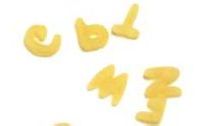
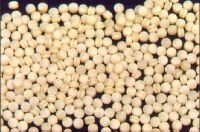
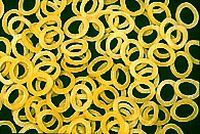
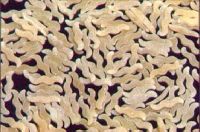
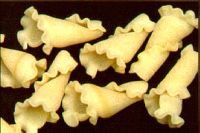
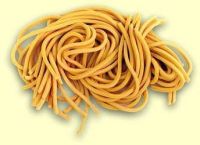
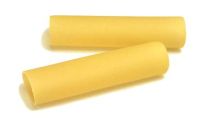
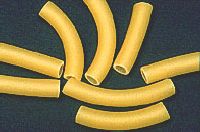
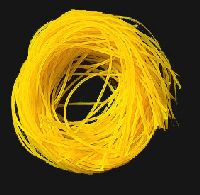
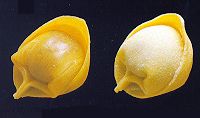
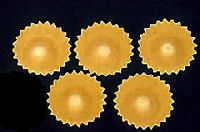
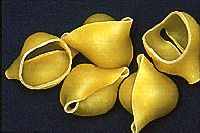
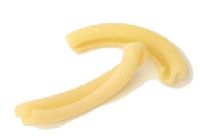
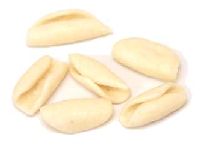
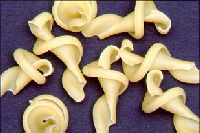
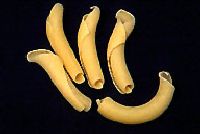
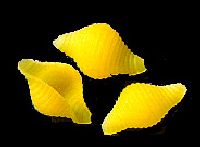
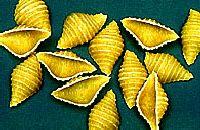
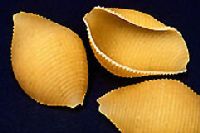
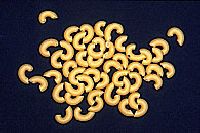
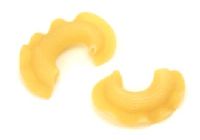
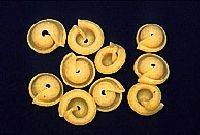
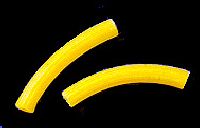
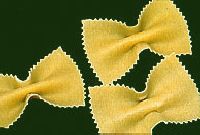
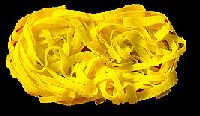
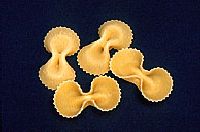
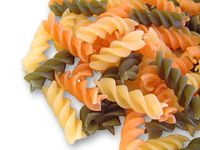
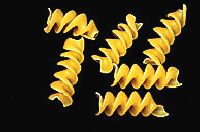
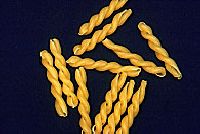
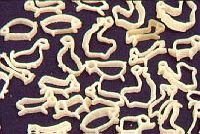
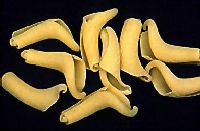
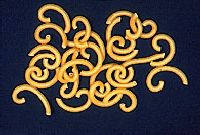
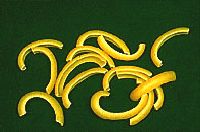


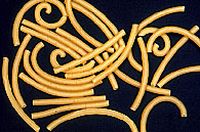
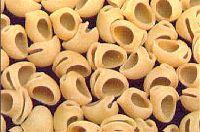
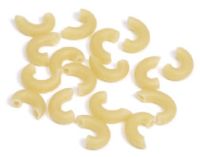
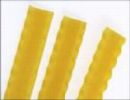
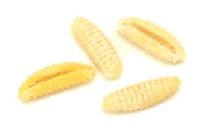
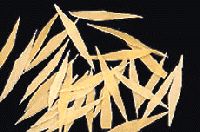
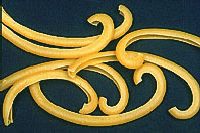
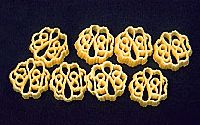
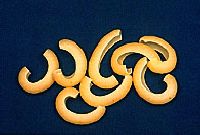

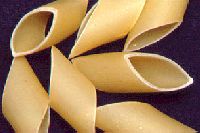
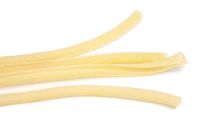
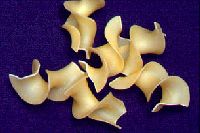
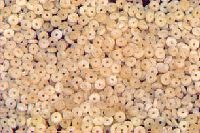
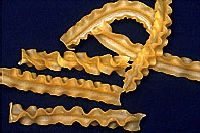
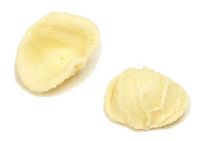
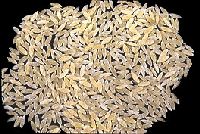
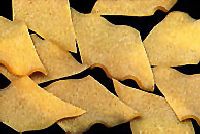
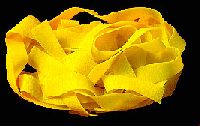
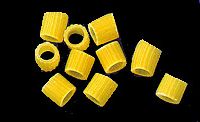
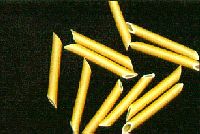
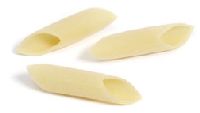
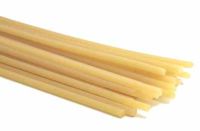
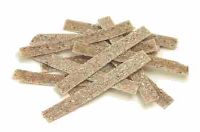
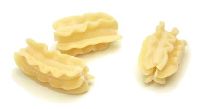
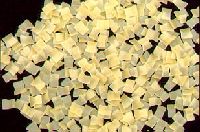
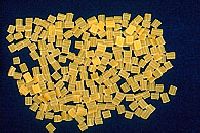
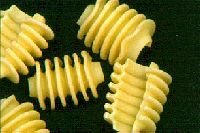

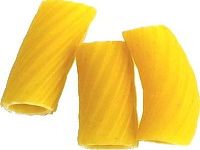
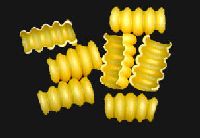
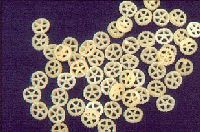
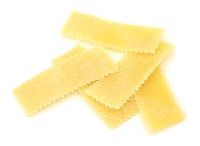
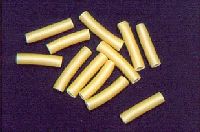
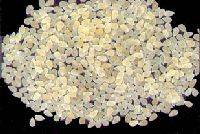
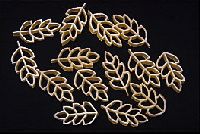
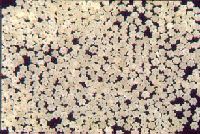
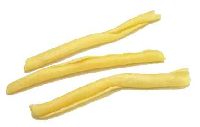
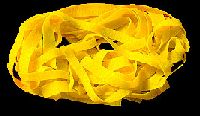
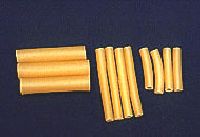
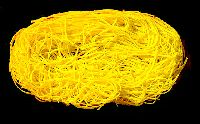
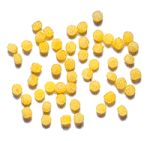

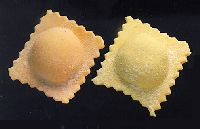
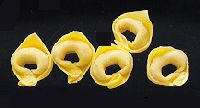
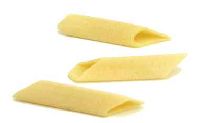
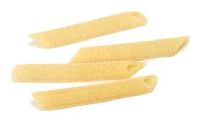
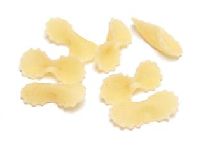
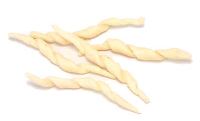
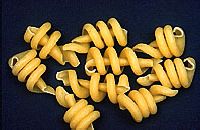
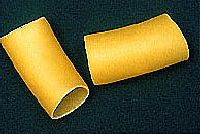
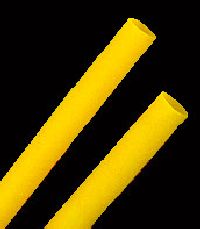



No comments:
Post a Comment